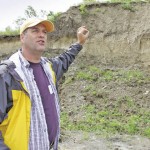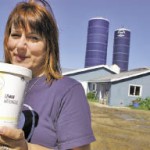
Tag Archives University of Manitoba

Churchill exports up after longer than usual shipping season
OmniTRAX says exporting crude oil through Churchill would help ensure the port’s viability

National soil science meeting meets Manitoba mud
A look back in time on Manitoba's escarpment — and a vision of what the future could be
Dale and Caroline Steppler’s farm on the Manitoba Escarpment was shaped by glaciers, but today the challenge is keeping nutrients from running down to Lake Winnipeg
In an abandoned shale pit a busload of muddied-shoed soil scientists from across Canada and beyond peer back millions of years into the geological history of this part of the Manitoba Escarpment west of Miami. Marine dinosaur fossils are routinely discovered nearby in the bentonite clay formed from prehistoric volcanic ash. They once swam inAgriculture Hall of Fame
Charles John Froebe was a significant force behind the development of cash advance programs
There were six Manitoban’s inducted to the Manitoba Agricultural Hall of Fame July 10. The Co-operator will publish the inductee profiles over the next six weeks.
Charlie Froebe was born at Carman, Man., Nov. 27, 1941. He grew up on the family farm in the Homewood district where he attended grade school and was a member of the Manitoba Sugar Beet 4-H Club. His secondary education was at St. John’s Ravenscourt in Winnipeg and Western Military Academy in Alton, Illinois. HeManitobans helping North Korean farmers
Manitobans with expertise in zero till and soil health are helping farmers increase productivity in the isolated nation
When it comes to North Korea, agriculture may not be the first thing that pops into people’s minds. But for the Mennonite Central Committee (MCC) it’s been front and centre for the last five years. The Winnipeg-based organization has been providing farmers in the Democratic People’s Republic of Korea with assistance with soil conservation and
Rethinking the possibilities of trees
The view from Northern Blossom Farms
In this third letter from Northern Blossom Farms, Gary Martens discusses ways to keep trees on the landscape.
In my first letter I advocated integrating livestock and crops for the synergistic benefits of both components to the farming system. In the next letter, I discussed my crop rotation which includes perennials but is still based mainly on annual crops. In this letter, I want to propose the integration of trees as a beneficialResearcher wants to know if farmers are happy with the contracts they sign
Production, marketing, and technology-use contracts are increasingly common but are they fair to farmers or tilted in companies’ favour?
Lots of farmers don’t like them but are production, marketing, and technology-use contracts unfair to farmers? “We still hear from our members that the contracts are typically quite one-sided,” said Doug Faller, policy manager with the Agricultural Producers of Saskatchewan. “Now with the changes to the wheat board and so on, the need for addressing
Made-in-Manitoba ice cream flying off store shelves
Customers are happily forking over between $11 and $12 for a litre of this premium, made-in-Manitoba ice cream
Lisa Dyck is going lickity split as summer arrives, ramping up production of a cool treat Manitobans haven’t tasted in a long time — made-in-Manitoba ice cream. This spring the Anola-area dairy producer launched Cornell Creme, a premium ice cream made from the milk of the 120 cows that she and husband William Dyck milk.
CCA hopeful resubmitted irradiation petition will succeed
The debate over whether to permit irradiation of beef products begins again

Where is AAFC’s wheat-breeding program headed?
After closing Winnipeg’s Cereal Research Centre, the federal government has invested $85 million in a new wheat research program in Saskatoon
Agriculture and Agri-Food Canada (AAFC) has led Canadian wheat breeding for more than 100 years, but recent actions by the federal government have some wondering about its future role. A year ago, Ottawa announced it will close AAFC’s venerable Cereal Research Centre on the University of Manitoba’s Winnipeg campus because it would cost too muchUniversal rotation principles uniquely applied to each farm
The view from Northern Blossom Farms - Part 2


